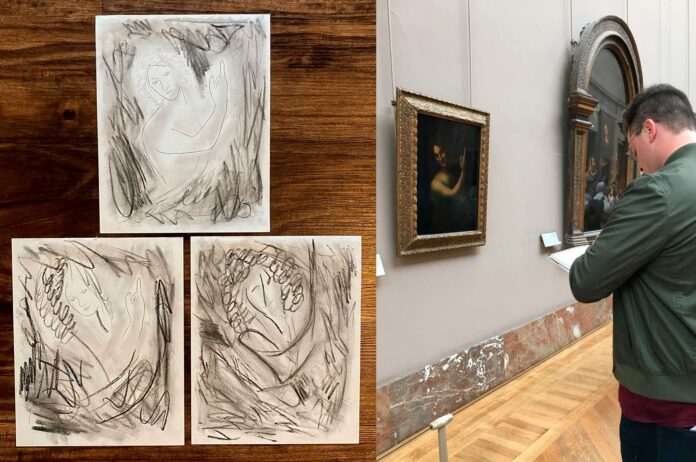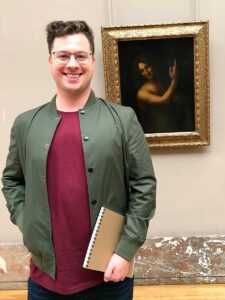
Tigard artist Alex LaFollette spent part of a morning copying Leonardo DaVinci’s most famous works inside The Louvre this fall. As one of 150 artists from around the globe granted ‘copyist’ permission this year, he joined a tradition that dates to the museum’s opening. When he got to the museum, he was surprised with permission to paint Mona Lisa in addition to the painting he was there to copy, Saint John the Baptist.

He sat down with Tigard Life to recount his adventure. The following is an edited excerpt of our conversation.
TL: You did so much homework and prep and talked to scholars to prepare. What was the experience of being face-to-face with Saint John the Baptist? What surprises did seeing the painting so close hold for you?
AL: Art, in general, is such an emotional experience, whether you’re viewing it or creating it. The work that I did to build up to going and creating my rendition, a lot of it was intellectual. All of that was very helpful, but it doesn’t really prepare you for seeing a Leonardo DaVinci in the flesh, just a couple of feet away from you. All the books in the world on Davinci can’t prepare you for actually being in its presence.
One of the more technical things I came across was just how well-curved the human bodies are in the paintings. They’re not flat surfaces at all. It looks like the people themselves are almost out of the painting, but it’s not kitsch. They’re so well-proportioned that it almost looks like they’re right there in front of you.
TL: Why did you choose to work with charcoal paint?
AL: The more I looked at Saint John the Baptist, the more I realized that DaVinci was using, it’s a fancy word, chiaroscuro, it’s a way of blending in different tones rather than working in a lot of colors. I opted to use a charcoal paint material where, depending on how hard I pressed down on it, the darker the charcoal paint would appear, but then the lighter I flicked my paintbrush, it looked more like a grey. If I flicked down even lighter on it, it almost looked like it was a silver. I wanted to pay homage to his method by picking up more of a total shading rather than picking out certain colors.
TL: Copying the Mona Lisa was a surprise. How did that come about?

AL: I walked up to one of the guards and showed them my permit. Pretty much the only instruction (the copyist program) gave me was to show the guards my permit so they don’t see just some random guy hanging out there with paints, painting away. (The guard’s) eyes got kind of big, then he looked at the Mona Lisa and said, ‘here, you can also paint this.’ He was very kind. He walked me up in front of the room, which was already packed. He brought me right up close to the Mona Lisa, and he said: “you can also paint this with your permit.”
TL: As you’ve had time to think back on it in the weeks you’ve been home, what were your big takeaways from the experience?
AL: One of my big takeaways is to be much lighter with the paintbrush. Just the light-handed nature of his work and how he would do many layers of ultra, light-handed paint strokes on top and that he was able to create that wonderful DaVinci effect is something I will carry with me.
Also, as a whole, is the way (the copyist program) makes me even more impressed with the museum, which I didn’t even think was possible. It’s this massive palace that’s built for artists. In one of the emails, Isabel, the director of the copyist department, said, “Welcome to the house of artists.” I think I now understand what she meant by that. The Louvre not only houses these great artworks, but it’s also meant for artists to come in and learn from and appreciate the work that’s there, to push their own limits and to challenge them. That line from her resonated a lot more with me when I was done.
To read Tigard Life’s original article on Alex LaFollette, visit tinyurl.com/yc87k3j5.























